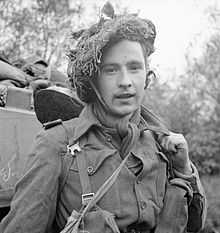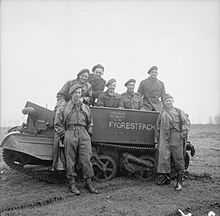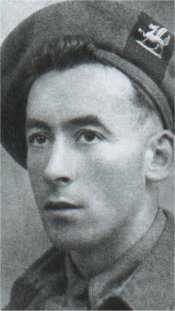Monmouthshire Regiment
| The Monmouthshire Regiment | |
|---|---|
| Active | 1908–1967 |
| Country |
|
| Allegiance |
|
| Branch | Infantry |
| Type | Territorial |
| Size | 3 battalions (peacetime) |
| Engagements | Second Boer War, First World War, Second World War |
The Monmouthshire Regiment was a territorial infantry regiment of the British Army. Originating in units of rifle volunteers formed in Monmouthshire in 1859, the regiment served in the Second Anglo-Boer War and the First and Second World Wars before losing its separate identity in 1967.[1][2][3][4][5]
Origins
Units of rifle volunteers were formed throughout Great Britain in 1859 and 1860 in response to a perceived threat of invasion by France following the Orsini affair. The raising of such units was to be authorised by lieutenants of counties in England, Wales and Scotland.[6] The first corps in Monmouthshire was raised on 9 September 1859.[1] By 1880 the various small corps in the county had been consolidated into three battalion-sized units, the 1st, 2nd and 3rd Monmouthshire Rifle Volunteer Corps.[1][2][3] In the following year the Childers reforms of line infantry saw the three Monmouthshire corps becoming volunteer battalions of the regular South Wales Borderers. In 1885 they were redesignated as the 2nd, 3rd and 4th Volunteer Battalions, South Wales Borderers (the 1st Volunteer Battalion being formed at the same time from the 1st Brecknockshire Rifle Volunteers).
Although the volunteer battalions saw no active service as units, during the Second Boer War they provided volunteer Active Service Companies to serve in South Africa, all of which were attached to the regular 2nd Battalion, South Wales Borderers, and they received the battle honour "South Africa 1900-02".[1][2][3][7]
Formation of the regiment
Reserve forces were reorganised under the Territorial and Reserve Forces Act 1907. Among other provisions the act abolished the Volunteer Force and replaced it with a new Territorial Force. Units were transferred, with changes in nomenclature, to the new force on 1 April 1908. [8]
The three Monmouthshire volunteer battalions were redesignated (and partially reorganised) as battalions of a new territorial-only Monmouthshire Regiment:[7][8]
- 1st (Rifle) Battalion. Based at Newport and formed from the 2nd Volunteer Battalion[1]
- 2nd Battalion. Based at Pontypool and formed from the 3rd Volunteer Battalion[2]
- 3rd Battalion. Based at Abergavenny and formed from the 4th Volunteer Battalion[3]
The Territorial Force was organised into 14 infantry divisions, and the 1st-3rd Battalions of the Monmouthshire Regiment, along with the 1st Battalion, Herefordshire Regiment, formed the Welsh Border Brigade, part of the Welsh Division.[4][5]
First World War
With the outbreak of war in August 1914 the Territorial Force was mobilised. In all the Monmouthshire Regiment formed battalions during the conflict as follows:[9][10]
- 1/1st (Rifle) Battalion: redesignation of 1st Battalion in September 1914 on formation of second-line 2/1st Battalion. Transferred to the newly formed 28th Division in France in February 1915, they quickly saw service in the Second Battle of Ypres, suffering severe casualties. In May 1915 they were temporarily amalgamated with the 1/2nd and 1/3rd Battalions at Vlamertinghe in Flanders to form a composite unit. Brought up to strength with reinforcements, the 1/1st resumed its own identity in August 1915. In September 1915 they were assigned to the 46th (North Midland) Division as a pioneer battalion. They remained with the division for the rest of the war, and were at Avesnes in northern France at the time of the Armistice with Germany.[1][4][5]
- 2/1st (Rifle) Battalion: formed as a second-line duplicate of the 1st Battalion in Newport in September 1914. It did not move outside the United Kingdom, performing home defence duties, mostly in Suffolk, as part of the 53rd and 68th Divisions. They were disbanded at Lowestoft in March 1918.[4][5]
- 3/1st (Rifle) Battalion: formed as a "third-line" duplicate of the 1st Battalion in February 1915. They remained in the United Kingdom (in Shropshire and Flintshire). In April 1916 they were redesignated as the 1st (Reserve) Battalion.[4][5]
- 1/2nd Battalion: redesignation of 2nd Battalion in September 1914 on formation of second-line 2/2nd Battalion. Transferred to the 4th Division in France in November 1914. They spent the winter taking part in trench warfare near Armentières. They subsequently took part in the Second Battle of Ypres in April and May 1915, fighting alongside the 1/1st and 1/3rd Monmouths in the 28th Division. Such were the losses that the three battalions were temporarily amalgamated. By July 1915 the 1/2nd had been brought up to strength and resumed its own existence. They transferred to the 29th Division as a pioneer battalion. They stayed in this role for the rest of the conflict, ending the war near Renaix in Belgium. They formed part of the army of occupation of Germany before returning to Pontypool where they were disbanded in June 1919.[4][5]
- 2/2nd Battalion: formed as a second-line duplicate of the 2nd Battalion in Pontypool in September 1914. Their service and stations were identical with those of the 2/1st Battalion. They were disbanded at Lowestoft in April 1918.[4][5]
- 3/2nd Battalion: formed as a "third-line" duplicate of the 2nd Battalion in February 1915. Their service and stations were identical with those of the 3/1st Battalion. In April 1916 they were redesignated as the 2nd (Reserve) Battalion and in September 1916 was absorbed by the 1st (Reserve) Battalion.[4][5]
- 1/3rd Battalion: redesignation of 3rd Battalion in September 1914 on formation of second-line 2/3rd Battalion. Transferred to the newly formed 28th Division in France in February 1915, fought alongside 1/1st and 1/2nd Battalions at the Second Battle of Ypres, due to losses they were temporarily amalgamated with the 1/2nd and 1/2nd Battalions. Brought up to strength with reinforcements, the 1/3rd resumed its own identity in August 1915. In September 1915 they were assigned to the 49th (West Riding) Division as a pioneer battalion. In 1916 they became GHQ troops. Due to the fact that many men in Monmouthshire were engaged in the vital wartime industries of coal-mining and steel making, it was found increasingly difficult to find drafts to reinforce the battalion, and on 31 August 1916 they were disbanded with troops transferred to the 1/1st and 1/2nd Battalions.[4][5]
- 2/3rd Battalion: formed as a second-line duplicate of the 3rd Battalion in Abergavenny in September 1914. Their service and stations were identical with those of the 2/1st and 2/2nd Battalions. They were disbanded at Herringfleet in August 1917, with troops transferred to 2/1st and 2/2nd Battalions.[4][5]
- 3/3rd Battalion: formed as a "third-line" duplicate of the 3rd Battalion in February 1915. Their service and stations were identical with those of the 3/1st Battalion. In April 1916 they were redesignated as the 3rd (Reserve) Battalion and in September 1916 was absorbed by the 1st (Reserve) Battalion.[4][5]
- 4th Battalion: a redesignation of the 48th Provisional Battalion, Territorial Force in January 1917. This unit had been formed in June 1915 from personnel of the Monmouthshire and Herefordshire Regiments ineligible for service overseas. Stationed in Norfolk.[4][5]
Inter-war
All units of the Territorial Force were disbanded soon after the end of the war in 1918 and 1919. Early in 1920 recruitment restarted and in October 1920 the force was renamed to the Territorial Army.[11][12] The three battalions were reconstituted in February 1920:
In 1921 it was announced that there was be a reduction in the size of the Territorial Army with a number of pairs of infantry battalions amalgamated.[13][14] The 3rd Battalion was amalgamated with the Brecknockshire Battalion, South Wales Borderers to become the 3rd (Brecknockshire and Monmouthshire) Battalion, The Monmouthshire Regiment in 1922.[3]
In 1938 and 1939 there was a reorganisation of the Territorial Army as the threat of a new European war re-emerged. Many infantry battalions were converted to an anti-aircraft role: in 1938 the 1st Battalion became a searchlight regiment and was transferred to the Royal Engineers and in 1940 to the Royal Artillery and ceased to be part of the regiment.[1]
In March 1939 it was announced that the size of the TA was to be doubled, with each existing unit forming a duplicate.[15][16] By June 1939 the regiment comprised three battalions:[7]
- 2nd Battalion
- 3rd Battalion (the amalgamation with the Brecknockshire Battalion had ended with the formation of a duplicate battalion)
- 4th Battalion (duplicate of the 2nd Battalion.)
Second World War

The 2nd Battalion was mobilised on the outbreak of war in September 1939. After a long period of training in Northern Ireland and England, they landed in Normandy on 28 June 1944 as part of the 160th Infantry Brigade attached to 53rd (Welsh) Infantry Division. They took part in Operation Epsom, spending two weeks in trenches between Hill 112 and the River Odon.[17][18]

They next saw action in the Battle of the Falaise Gap in August 1944, and advanced with the 53rd Welsh Division, liberating Merville and crossing into the Netherlands. By October they had reached the Nederrijn and took part in the attack on 's-Hertogenbosch.[17]
In December 1944 they took part in the counter offensive against German advances in the Ardennes.[17] In January 1945 they moved to The Netherlands for a period of training prior to Operation Veritable (the Battle of the Reichswald). They entered Germany on 8 February, taking part in a month's heavy fighting and suffering 300 casualties before being withdrawn for rest.[17]
The battalion continued to advance across Germany, forcing a crossing of the River Aller at Rethem on 11 April. This was their last major action of the war: they were at Hamburg when the German Instrument of Surrender came into effect.[17]

The 3rd Battalion was mobilised along with the 2nd Battalion as part of the 159th Infantry Brigade part of the 53rd (Welsh) Infantry Division and trained alongside it in Northern Ireland and England. In 1942 they were transferred to 11th Armoured Division. On 14 June 1944 the battalion landed in Normandy. They spent several weeks attempting to break out of the bridgehead in the vicinity of Caen as part of Operation Goodwood and Operation Bluecoat. On 5 August they were nearly surrounded by enemy forces on Bas Perier Ridge and suffered heavy casualties, forcing them to temporarily amalgamate with the 1st Battalion of the Royal Norfolk Regiment.[18][19]
Reinforced, the battalion advanced after the retreating German forces, passing through Belgium and taking part in the liberation of Antwerp. They moved into the Netherlands as part of the force protecting the flanks of the airborne troops that had landed in Operation Market Garden.[19] The commanding officer of the battalion, Lieutenant-Colonel Hubert Gerald Orr, was killed on 25 September 1944 at Sint Anthonis along with the C.O. of the 3rd Royal Tank Regiment.[19][20] In November 1944 they took part in the Battle of Broekhuizen (also known as the Battle of the Venlo Pocket)

In February 1945 they broke through the Schlieffen line after which they were withdrawn to Belgium where they were re-equipped for the advance into Germany. In April 1945 they crossed the Rhine into the Teutoburg Forest where they had the task of clearing the road to Ibbenbüren. The battalion encountered very heavy resistance and failed to achieve its objective. Corporal Edward Thomas Chapman was awarded the Victoria Cross for his actions during this action.[19]
Such were the battalion's casualties that it took no further part in the conflict and its place in the 159th Brigade was replaced by the 1st Battalion of the Cheshire Regiment. It was disbanded in January 1946.[19]
The 4th Battalion, which had been created on 1 June 1939 as a duplicate of the 2nd Battalion, was mobilised in August 1939 as part of 38th (Welsh) Infantry Division. The battalion did not leave the United Kingdom, performing guard duty and acting as a training unit. On 12 December 1942 it was redesignated the 1st Battalion, South Wales Borderers; the original 1st SWB having been disbanded after most of the unit was captured in North Africa.[18][21]
Post War to amalgamation
All Territorial and war-formed units were disbanded soon after the end of the war. The Territorial Army was re-established in April 1947, although there was a considerable reconfiguration with some pre-war units not reformed, or converted to a different role.
The Monmouthshire Regiment was reduced to a single battalion: the 2nd Battalion, based in Pontypool.[2] The 3rd Battalion was converted to an anti-aircraft unit of the Royal Artillery and ceased to be part of the regiment.[3]
In 1967 the battalion was disbanded. A new unit, the Welsh Volunteers, continued the lineage of all Welsh territorial infantry battalions. The successor unit today is the 3rd Battalion, the Royal Welsh.[2][7]
Battle honours
The regiment was awarded the following battle honours. Those shown in bold type were selected for display on the colours or appointments.[1][2][22]
- South Africa 1900-02
- Ypres 1915 '17 '18
- Gravenstafel
- St. Julien
- Frezenberg
- Bellewaarde
- Somme 1916
- Albert 1916
- Arras 1917
- Scarpe 1917
- Pilckem
- Langemarck 1917
- Poelcappelle
- Cambrai 1917 '18
- Lys
- Messines 1918
- Hindenburg Line
- St. Quentin Canal
- Beaurevoir
- Courtrai
- Sambre
- France and Flanders 1914-18
- Aden[10][22][23]
- Odon
- Bourguébus Ridge
- Mont Pincon
- Souleuvre
- Le Perier Ridge
- Falaise
- Antwerp
- Nederrijn
- Lower Maas
- Venlo Pocket
- Ourthe
- Rhineland
- Reichswald
- Weeze
- Hochwald
- Rhine
- Ibbenburen
- Aller
- North-West Europe 1944-45
References
- Margesson, John (1977). A Short History of the Regiment of Wales (24th/41st Foot). Royal Regiment of Wales.
- ↑ 1.0 1.1 1.2 1.3 1.4 1.5 1.6 1.7 1.8 Mills, T F. "1st Battalion, The Monmouthshire Regiment". Regiments.org. Archived from the original on 26 January 2008. Retrieved 4 May 2013.
- ↑ 2.0 2.1 2.2 2.3 2.4 2.5 2.6 2.7 Mills, T F. "2nd Battalion, The Monmouthshire Regiment". Regiments.org. Archived from the original on 12 January 2008. Retrieved 4 May 2013.
- ↑ 3.0 3.1 3.2 3.3 3.4 3.5 3.6 Mills, T F. "3rd Battalion, The Monmouthshire Regiment". Regiments.org. Archived from the original on 20 October 2007. Retrieved 4 May 2013.
- ↑ 4.0 4.1 4.2 4.3 4.4 4.5 4.6 4.7 4.8 4.9 4.10 4.11 Baker, Chris. "The Monmouthshire Regiment". The Long, Long Trail. The British Army in the Great War of 1914-1918. Retrieved 4 May 2013.
- ↑ 5.0 5.1 5.2 5.3 5.4 5.5 5.6 5.7 5.8 5.9 5.10 5.11 "The Monmouthshire Regiment TF World War I. Fact Sheet: 7-B07-11" (PDF). The Regimental Museum of The Royal Welsh (Brecon). Retrieved 4 May 2013.
- ↑ War Office Circular, 12 May 1859, published in The Times, 13 May.
- ↑ 7.0 7.1 7.2 7.3 Margesson (1977) pp.85-86
- ↑ 8.0 8.1 Order in Council dated 19 March 1908 The London Gazette: (Supplement) no. 28121. pp. 2149–2162. 20 March 1908.
- ↑ Margesson (1977) p.17
- ↑ 10.0 10.1 "South Wales Borderers and Monmouthshire Regiment. Summary of the Great War 1914-1918. Fact Sheet 3-B7-12" (PDF). Retrieved 5 May 2013.
- ↑ "New Territorial Army – The Government Scheme". The Times. 31 January 1920.
- ↑ "New Citizen Army – 2nd Line Defence Scheme". The Times. 31 January 1920.
- ↑ "Territorial Army Reduction". The Times. 15 July 1921.
- ↑ "Territorial Army Amalgamations – 40 Battalions Affected". The Times. 5 October 1921.
- ↑ "Territorial Army - Establishment doubled". The Times. 30 March 1939.
- ↑ "13 Additional Divisions - Method of Expansion". The Times. 30 March 1939.
- ↑ 17.0 17.1 17.2 17.3 17.4 "2nd Battalion The Monmouthshire Regiment TA. World War 2. Fact Sheet 7-B09-07" (PDF). Regimental Museum of the Royal Welsh (Brecon). Retrieved 5 May 2013.
- ↑ 18.0 18.1 18.2 Margesson (1977) p.20
- ↑ 19.0 19.1 19.2 19.3 19.4 "3rd Battalion The Monmouthshire Regiment TA. World War 2. Fact Sheet 7-B09-08" (PDF). Regimental Museum of the Royal Welsh (Brecon). Retrieved 5 May 2013.
- ↑ "Orr, Hubert Gerald". Casualty Details. Commonwealth War Graves Commission. Retrieved 5 May 2013.
- ↑ "4th Battalion The Monmouthshire Regiment TA. World War 2. Fact Sheet 7-B09-09" (PDF). Regimental Museum of the Royal Welsh (Brecon). Retrieved 5 May 2013.
- ↑ 22.0 22.1 The battle honour "Aden" was awarded for the services of the 1/1st Brecknockshire Battalion, South Wales Borderers. The Battalion had been merged with 3rd Battalion Monmouthshire Regiment in 1922, and the battle honours for the First World War were awarded in 1924.
- ↑ "Battle Honours. Further List of Awards.". The Times. 10 April 1924. p. 8.